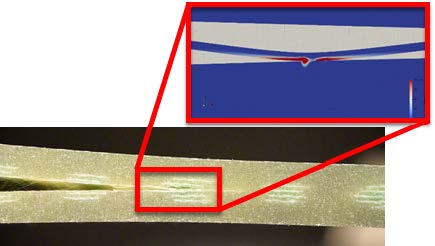Tunable Fracture Toughness in Composite Laminate
A process to prevent delamination failure and increase the long-term safety and performance of composite structures while reducing costs and adverse impacts.

Delamination is a common failure in laminate composite structures. Delamination between plies (interply-delamination) occurs more frequently than fracturing within one ply (intraply-damage). Interply-delamination may be initiated by defects introduced during the material manufacturing process, such as porosity, resin-starved regions, damage from machining, or poor material handling. This damage can also be produced by low velocity impacts which are difficult to detect due to minimal surface damage.
A process using interfacial modifiers developed by Sandia researchers addresses the problem of interply-delamination. Modifiers that are embedded in the matrix layers between plies can significantly reduce the propagation of interply-delamination events. Modifier patterns and composition can be selected and tuned layer-to-layer to achieve specific design outcomes, such as channeling crack propagation to or from specific locations to maximize the capabilities and impact of embedded sensors, or minimize the overall failure mode consequences. By suppressing interplay-delamination the structure’s overall failure mode can also be tuned to exhibit varying degrees of interply-delamination or intraply damage through fiber fracture.
Modifiers can be arranged with any desired pattern to optimize or enhance the composite structure’s properties, and to reduce interply-delamination failure. They can be easily introduced with existing thermoset or thermoplastic resin materials. The manufacturing costs of incorporating the modifiers is anticipated to be minimal, as a variety of manufacturing methods can be used, such as manual deposition, additive manufacturing, localized heating or light exposure, and using cut films.
- Easily customized to meet specific design requirements
- Controls or reduces mechanical force transmission
- Enables design control of crack propagation
- Aerospace
- Transportation
- Wind
SD 15369
Published1/5/2022
Last Updated1/5/2022